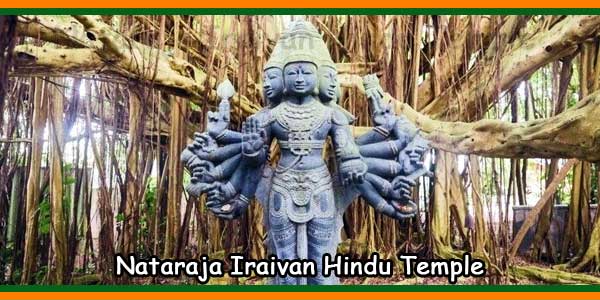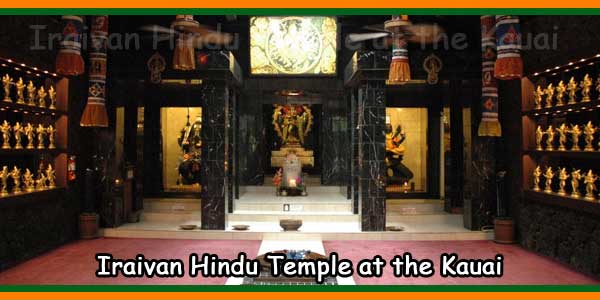Kauai Iraivan Hindu Temple Timings: 9.00 AM and 12.00 Noon.
Kadavul is our Nataraja temple, established in 1973, where monks worship and meditate together each morning. There is a sixteen-ton Nandi bull who loves Siva day and night from his pavilion across the street.
Kadavul Temple is open daily from 9:00 AM to 12:00 Noon. Please come early because the grounds of the monastery close at noon. Members of the Hindu faith can ask for archana.

Read on to learn more about the scriptures, the denomination of Hinduism and the specific philosophy followed in the temple of Kadavul, as well as the worshiped deity, the priests who worship him, and the dynamic vision of the founder who manifested the temple.
General Information:
The Hindu temple of Kadavul is a traditional temple of Siva of Sri Lanka. It is the spiritual core of Kauai Aadheenam, a 363-acre monastery / temple, also known as the Kauai Hindu Monastery. It is the main temple for resident monks, who gather here every morning for Siva Puja in the early hours before dawn. The monks turn in three hours of vigils during the twenty-four hours during which they worship, meditate, sing, practice Sanskrit and practice personal spiritual disciplines. This sadhana has been maintained in uninterrupted continuity since the temple was established in 1973, which adds to the profound power of the temple that changes the lives of many visitors, as do the ancient temples of southern India.
The supreme god Siva is consecrated in the main sanctuary in the form of Nataraja and a crystal of Sivalingam. Before the Shrine of Siva there is a 700-pound, 3-foot-tall glass, naturally formed, Sivalingam (one of Sphatika Svayambhu’s largest Lingams in the world) that one day will become the main image of worship in white granite carved by hand. The Iraivan temple is being built near the property of the monastery. Six-foot black granite murtis of Lord Ganesha and Lord Murugan (Kartikeya, mounted on a peacock and named Shikivahana) are installed on two side sanctuaries. There is also a Murti of Ardhanarishvara and a complex silver trident (trishula), symbol of the three basic powers of desire, action and wisdom of God Siva. The alignment of the main walls of the temple is a rare collection of 108 positions Siva’s tandava dance in bronze icons of 16 inches high covered with gold leaves. The shrine of the temple’s founder, Satguru Satguru Sivaya Subramuniyaswami, affectionately known as Gurudeva (1927-2001), was created to the right of the gateway on the first anniversary of his mahasamadhi. Located right in front of the temple is a lava stone and a red wooden awning for the Nandi bull, the Siva mountain and piles, form a giant weighing 32,000 pounds, carved from a single stone. A small temple has a bronze statue of Saint Sambandar, dancing happily. The Kadavul Temple is open to the public daily from 9am to noon.
VIGILS CONTINUOUSLY PERFORMED IN KADAVUL BY THE MONKS:
Every 3 hours
8 times a day
7 days a week,
52 weeks a year
From March 12, 1973, to today: 131881 vigils performed

Mata – The Hindu Denomination:
The Hindu Kadavul Temple follows the Saivite tradition, the oldest of the four main denominations of Hinduism. In Tamil language of South India, our religion is known as Saiva Samayam, or simply Saivam. We worship the only Supreme Being as Lord Siva, and the Lords Ganesha and Murugan, whom God Siva created to assist in the care of His great creation. In Saivism, Shakti is the manifest power of lord Shiva and is not separate from Him, which is more clearly represented in the image of Lord Shiva as Ardhanarishvara, whose left side is female and the right side is male. In Kadavul, there is no separate Godhead who represents Shakti, because in our tradition the Supreme Being is neither a man nor a woman, but embraces both.
Agama – The Scriptures:
Each Hindu temple is based on a sacred text as a source of spiritual ritual, usually an Agama. The Agamas are a vast collection of Sanskrit scriptures that, along with the Vedas, are revered as revealed scriptures. Like the Vedas, the Agamas (literally, “what came down”) were part of an oral tradition. With only 7,000-8,000 years, the Agamas are the main source and authority for the construction of rituals, yoga and temples. In the sivaitic tradition of southern India, there are 28 Saiva Agamas. As in the temples led by the Sivacharyas of southern India, the traditional liturgy performed in the Hindu temple of Kadavul takes as spiritual authority the Kamika and Karana Agamas and their derived priestly manuals.
Murti – The Deity:
We worship the Supreme Being as Siva, enshrined in the main sanctum in two forms: a spotless crystal Lingam and a 6-foot-tall bronze murti of Nataraja. Worship of the Sivalingam in India dates back to the very beginning of the Saivite religion, millennia ago. The Lingam is the most prevalent emblem of Siva, found in virtually all Siva temples. It is the simplest and most ancient symbol of God representing Absolute Reality, Parasiva, beyond all forms and qualities. Nataraja, “King of Dance,” is perhaps Hinduism’s richest and most eloquent symbol, representing God with form, known as Parameshvara, the “Supreme Ruler” or Primal Soul. The dance of Siva is the dance of the entire cosmos. Within the symbolism of Siva’s dance we find His five powers, or shaktis: 1) creation or emanation; 2) preservation; 3) destruction, dissolution or absorption; 4) obscuring grace, the power which hides the truth, thereby permitting experience, growth and fulfillment of destiny; and 5) revealing grace, which grants knowledge and severs the soul’s bonds. Temples with prominent Nataraja images are rare and are found primarily in South India, most notably at Chidambaram, though there are Nataraja temples in Sri Lanka and Kashmir.
Archana – The Priesthood:
As Kadavul Hindu Temple is part of a monastery, the mathavasis, or monastics, naturally form its primary priesthood. The monks’ potent spiritual disciplines make the temple powerful, its vibration pure. The monks perform pujas every three hours in Kadavul Temple, 24 hours a day, 365 days a year. The primary daily puja is held at 9:00am. Under the aegis of the late Sivashri Dr. T.S. Sambamurthy Sivachariar, head of the South India Archaka Sangam, Adisaiva priests came to Kauai’s Hindu Monastery in the mid-1980s to train qualified monastics in the art of parartha puja, “worship for the benefit of others,” to be performed daily in the Aadheenam’s established temples. Up until this time, only Saivite brahmins of the hereditary Adisaiva priest lineage were entitled to conduct rites in Agamic Siva temples. Kadavul Temple brings adept Adisaiva priests from South India or elsewhere for special ceremonies, such as kumbhabhishekams and other major events. Sometimes we also have unmarried Adisaivas help with the daily pujas in the temple and provide additional chanting and pujari training to the mathavasis.
Darshana – The Philosophy:
The philosophy followed and taught at Kadavul Hindu Temple is the non-dualistic Saiva Siddhanta (Advaita Siddhanta) of Rishi Tirumular and his guru, Maharishi Nandinatha (ca 250 bce), which proclaims that God Siva is Love, both immanent and transcendent, both the creator and the creation. He is the totality of all, understood in three perfections: Parameshvara (the Personal Creator Lord), Parashakti (the energy which permeates all form) and Parasiva (Absolute Reality which transcends all). Simply put, God Siva is all, and is in all. Souls and world are identical in essence with Siva, yet also differ in that they are evolving. This philosophy differs from the dualistic form of Saiva Siddhanta propounded by Meykandar (ca 1250 ce), which teaches that God is Lord and Creator, but He remains ever separate from man and the world.
Anubhava – The Vision:
It is said that the most powerful temples are those founded by the Gods themselves through visions. Kadavul Hindu Temple is such a temple. Gurudeva describes his vision and the events leading up to the temple’s founding: “At Mahasivaratri time in 1973, in the jungles of Kauai, our Kadavul Nataraja Deity, Lord of the Dance, arrived at Kauai Aadheenam and was placed in the gardens overlooking the sacred Wailua River, where it was spontaneously decorated, bathed and worshiped. That night the exact location of the Deity’s installation was chosen by Lord Muruga Himself when He appeared to me in an early morning vision, upturned His glistening vel, His scepter of spiritual discernment, and powerfully pounded its point three times on the cement steps at the Aadheenam entrance, marking the precise spot to place the Deity.” This mystical vision marked the founding of Kadavul Hindu Temple. Shortly after the installation of the Nataraja Deity, Gurudeva received what he called “a magical boon” of reading clairvoyantly from inner-plane manuscripts, which he then dictated to his monks over a two-year period. These writings from the devas and Mahadevas formed the shastras, spiritual instructions, that now guide his monastic order. During the same time, Gurudeva received devonic directions that written prayers could be sent to the inner world devas by being burned in the sacred fire inside Kadavul Temple. On auspicious days, hundreds of prayers from all over the world are offered into the temple fire. The magical happenings and answers to these petitions have become part of the temple’s renown. Writing and delivering prayers to the Devaloka through the sacred fire is an ancient Natha Sampradaya practice. Today this method of communication is still employed in Shinto and Taoist temples in Japan, China, Singapore, Malaysia and other areas of Southeast Asia. The prayers are written down and placed in the temple fire. As the paper burns, the astral double of the prayer appears in the Devaloka. The prayer is then read by the devas, who proceed to carry out the devotee’s requests. These temple devas are fully dedicated to assist all who come through the temple doors with their emotional, mental and physical problems.
For Other Questions Email to contact@hindu.org
Mailing Address:
Himalayan Academy
Kauai’s Hindu Monastery
107 Kaholalele Road
Kapaa, HI 96746-9304
Phone: 1-808-822-3012
Fax: International: 1-808-822-4351
Minimela Gift Shop:
Email: books@hindu.org
For Telephone orders (24/7): 1-877-255-1510
Customer service (Hawaii daytime): 1-808-822-7032, ext 103
Hinduism Today Magazine:
Letter to the editor: www.hinduismtoday.com/letters
Subscriptions: www.hinduismtoday.com/subscribe
Telephone: (toll free from USA and Canada): 1-877-255-1540, (international): 1-808-822-3012.
Fax: (toll free from USA and Canada): 1-888-217-3108, (international): 1-808-822-3152
Hindu Heritage Endowment:
Email: hhe@hindu.org
Telephone: 1-808-822-3012 ext. 0
Fax: 1-888-217-3108 (within USA and Canada) or 1-808-822-4351 (international)
